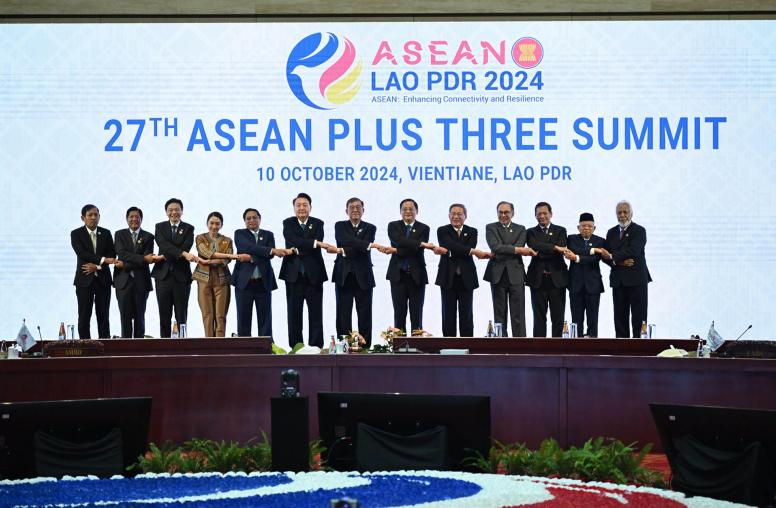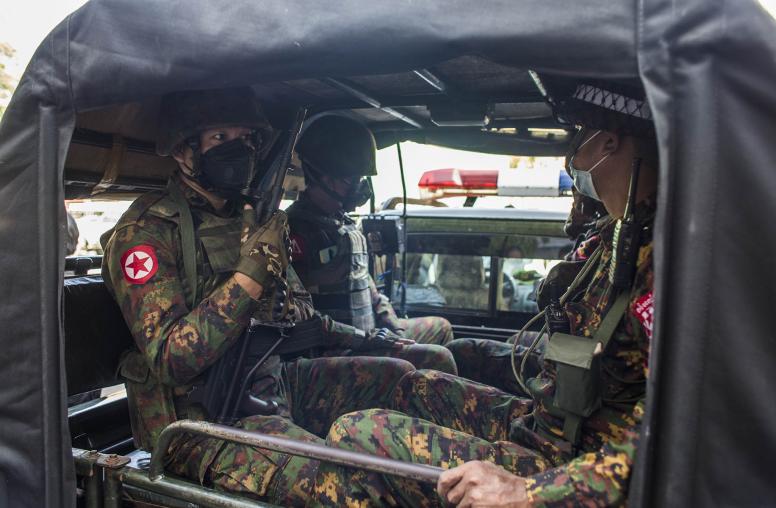China’s High-Stakes Calculations in Myanmar
Beijing is betting the military junta will best protect its interests, possibly setting the stage for a prolonged civil war.
The ultimate outcome of Myanmar’s nine-week-old coup will affect a range of international actors — but none more than China. As Asia’s greatest power, China has strategic and economic stakes in its neighbor to the south that leave little space for genuine neutrality behind a façade of non-interference. Since February 1, Beijing has profoundly shaped the trajectory of post-coup violence and blocked international efforts to restore stability. Although China has strong incentives to avert chaos or collapse, it more importantly views Myanmar as a battleground for preventing the encroachment of democratic values and Western interests on its periphery. Consequently, Beijing will continue to lend cautious support and legitimacy to a tyrannical and capricious military dictatorship.

China experts have long identified three key interests of Beijing in Myanmar. The first is to maintain stability in the China-Myanmar borderlands, where fighting between the military and powerful armed groups based along the China border will impact China’s national security interests. Second, China aims to protect and advance a strategic economic and energy corridor linking its southwestern provinces to the Indian Ocean. Third, China seeks to prevent the internationalization of Myanmar‘s conflicts, particularly preventing Western influence in the borderlands.
Fallout from the coup threatens all three.
In the border area, fighting broke out almost immediately after the military seized power, first involving attacks by two organizations belonging to the Brotherhood Alliance based there — the Ta’ang National Liberation Army and the Myanmar National Democratic Alliance Army. Observing that the third member of their alliance, the Arakan Army, was positioned to benefit from the coup by consolidating territory acquired in Rakhine State since a 2019 cease-fire with the military, the two groups saw the post-coup landscape as an opening to realize their own territorial ambitions in the North. As the Myanmar army moved to counter these efforts, the neighboring Kachin Independence Army began fighting back, attacking police stations in the Kachin capital.
While China urged armed groups dependent on it for supplies, trade and economic development to use restraint, this became increasingly untenable by mid-March as the military’s brutal crackdown on popular resistance to the coup continued and spread across Myanmar’s ethnic states. Facing significant pressure from their constituencies, these ethnic armed groups expanded military operations.
Securing China’s Border
With the Tatmadaw, as the Myanmar military is known, now deploying air strikes in Kachin and Shan states, China recognized the conflict will inevitably spill across the frontier. On March 29, Chinese authorities took the drastic step of locking down the border and bolstering security in southern Yunnan province under the pretext of controlling COVID-19.
China’s economic interests also face a significant post-coup threat — in large part because Beijing refused to recognize that a coup had occurred. In the power grab’s immediate aftermath, thousands of protesters targeted China’s embassy in Yangon, demanding that it withdraw support from the Tatmadaw. As China maintained its “wait and see” posture, the Myanmar public threatened to shut down or even destroy major Chinese investment projects.
The threat materialized in early March when dozens of Chinese textile factories around Yangon suffered serious damage in a mysterious, coordinated attack that caused losses of about $37 million. Meanwhile, Burmese regularly post pictures online of pipeline explosions, threatening China’s most important investment in Myanmar, the Myanmar-China pipeline project, which provides 13 percent of China’s natural gas imports and supplies oil to a multi-billion-dollar refinery outside of Kunming. Although the Tatmadaw has assured China it can protect its investments, the chaos has seriously disrupted the lucrative border trade, rendered planning impossible for a rail line connecting the Chinese border to Mandalay, and halted the majority of Chinese construction projects in lower Myanmar.
Broken Democratic Ties
China could ease this pressure by moderating its approach. Yet it has refused any contact with the deposed ruling party, the National League for Democracy (NLD), and its current representation, the Committee Representing Pyidaungsu Hluttaw (CRPH), Myanmar’s parliament.
Beijing’s initial post-coup statements did not even mention these stakeholders. It then shifted its position on March 7, when State Councilor Wang Yi issued a three-point proposal that specifically included the NLD. Still, through March the Chinese government ignored the NLD’s requests for meetings. It also ignored a likely olive branch proffered by the CRPH; without targeting a single Chinese company, the lawmakers group issued open letters to international investors in Myanmar demanding that they cease payments to the coup government.
By late March, China began signaling stronger support for the junta. First, it hosted the Russian foreign minister in Guangxi, China, on March 22, where the two officials issued a joint statement expressing concern that foreign powers are “exploiting the situation in Myanmar to advance their own interests,” and saying that this must be prevented.
Then, on April 3, Wang Yi issued a new statement, dropping all mention of China’s relations with the NLD. This statement called for preventing further bloodshed; blocking United Nations Security Council involvement in Myanmar; and stopping “foreign powers from exploiting chaos in Myanmar to advance their selfish interests.” The statement makes the hierarchy of priorities among China’s core interests abundantly clear: limiting foreign influence and preventing internationalization of the conflict are top concerns, while engaging with the country’s democratically elected leadership is unnecessary.
Also in late March, ahead of the high-level meeting with the United States in Alaska, China did send signals that it might be willing to mediate the conflict in Myanmar, but with an eye toward securing concessions on Xinjiang, Tibet, Hong Kong or trade. From the U.S. perspective, this would be disastrous for regional allies.
Backing the Tatmadaw
That explains China’s sudden turn to Russia, and Russia’s foray into Myanmar’s domestic politics through its high-level participation in the Tatmadaw’s Armed Forces Day celebration on March 27 — which sent a strong signal of Chinese and Russian willingness to continue protecting the Tatmadaw. An essay published by the Chinese think tank Taihe Institute illustrates the narrative forming in China around Beijing’s position: “The [Civil Disobedience Movement] is fully backed by Western NGOs…meanwhile the CRPH has popular support...but is extremely weak compared to the military, it is an illegal association, and its leaders are wanted for sedition.”
China would likely prefer that the coup government emerges victorious over the civil disobedience movement and the NLD, thereby driving a deep wedge between its southern neighbor and the West. At the same time, China also sees clearly that the majority of ethnic armed organizations face serious public opinion costs if they fail to reject the coup and support the oppressed population.
Given the degree to which many of the ethnic armed organizations in the north are dependent on China, Beijing does not mind them expanding their influence; it could benefit China in future bargaining with a weakened, but still intact, coup government. China’s warnings to the Kachin Independence Army on April 3, though, made it clear that Beijing does not want any armed groups within its sphere of influence to align militarily with either the CRPH or other armed organizations outside of China’s security umbrella.
As such, China’s actions play a big part in steering the trajectory of the conflict, shaping the extent of potential alliances or picking likely victors in an ongoing contest.
Bad Bet on Force
A major flaw in China’s analysis is its assumption that the civil disobedience movement and the CRPH have no autonomy, or that they are doomed to fail without international support. Despite the Tatmadaw’s use of lethal violence and its institution of a nationwide reign of terror, the movement remains strong, and its support from ethnic armed groups continues to increase. The CRPH’s moves to abolish the constitution and introduce a federal charter have further bolstered its support from the public and the ethnic nationalities, uniting all nationalities in their opposition to the Tatmadaw for the first time.
China’s non-interference policy has recognized the party with the gun, but the gun is the only tool that the Tatmadaw now has available to hold onto power and maintain rank and file discipline. By viewing Myanmar as a battleground for keeping Western values and influence out of its periphery, China is gradually losing any possible support from the Myanmar public and from the armed groups, including those dependent on China.
China’s position has set the stage for a prolonged and extremely bloody war — an eventuality contrary to the interests of the Myanmar people, Association of Southeast Asian Nations countries and the United States.
The United States and its allies need to look closely at the approach China is taking in Myanmar and identify much more robust tactics to prevent Beijing’s narrow view of its interests in Myanmar from leading to mass atrocities. The United States and its allies in Asia, particularly the Quad (the United States, Japan, Australia and India) should provide concerned Southeast Asian states with vigorous support to steer a new course of action against Tatmadaw violence. Meanwhile, much stronger action by the United States and its allies should be considered against Russia and China, both of which have opted to ignore means of restoring stability and risk creating a regional crisis in order to eradicate so-called Western influence in Myanmar.



